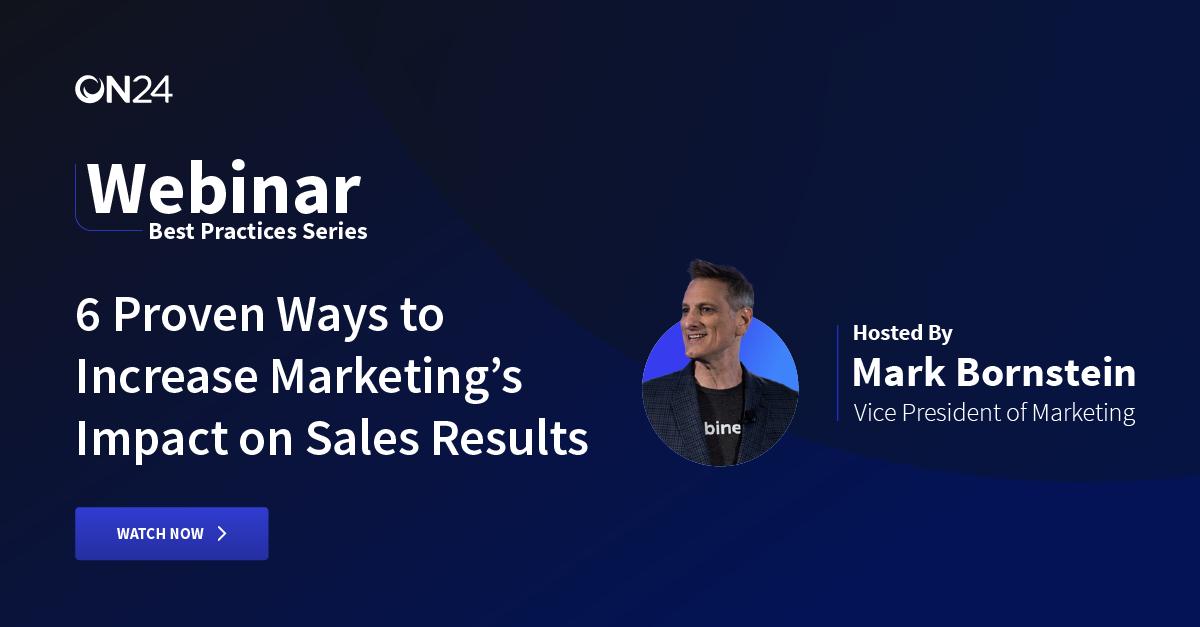Webinar programs, whether as a one-off event or a webinar series, are essential assets that B2B marketers must use to connect with today’s digital-first buyer. In fact, according to the 2023 Digital Engagement Benchmarks, audience engagement with webinars is intensifying, driving, on average, 55 minutes of engagement with attendees.
But how can a B2B marketing team optimize their webinar program? What makes for a successful webinar in the first place?
We’ve compiled this guide to optimizing B2B webinar programs to answer these questions and more. Read on to learn how to:
Design webinars for customer engagement
Use webinars to optimize customer success
Optimize B2B landing pages
Optimize webinar attendance for lead acquisition
Use webinars to boost MQLs
Optimize webinars for customer success
How to design webinars for customer engagement

To optimize and meet your goals, you must first measure performance, no matter what medium you use to acquire, engage and convert customers. But knowing which metrics are relevant — and those that aren’t — isn’t always easy.
When optimizing your B2B webinars, understanding which signals show audience interest, intent and engagement is always a good guide. The importance of each metric varies by your organization’s goals, but good metrics to measure include:
-
- Questions asked
- Conversion rate
- Polls and surveys answered
- Number of events attended
Engage with customers on their terms
Customers don’t follow linear paths when it comes to the buying journey. A marketer may want an attendee to download a particular piece of content or sign-up for a particular session, but audiences often have different plans.
To overcome this basic hurdle, ensure engagement is at the center of the audience experience. Fill your webinars with engaging content make them available live and on-demand. Organizing your on-demand webinars in easy-to-navigate content hubs, or even specialized landing pages (for example, for target accounts), will help visitors choose their own journey — and allow you to collect the engagement data to improve it over time.
Cater to customer interests
Before creating anything, ask yourself: does this help address the needs of my target audience? Is it compelling? If the answer to either is no, rethink your content. If you already have detailed customer personas, use these as an aide to review your content offerings.
But, even then, how can you know if your content resonates? This is where metrics come in. Specifically, keep an eye on:
-
- Webinar conversion rate
- Time spent in webinar
- Engagement score
- Audience engagement (polls, survey, Q&A)
- CTAs clicked within the event
- Registrations
Use Webinars to Optimize Customer Success

Work with your account manager and customer success teams to enhance customer success and align on what a good customer success journey looks like. Examine each step and pinpoint where marketing can help. Typically, you’ll need to review:
1. Onboarding
Look at how customers are brought on board. What are the first steps the customer success team takes to welcome customers to your product or service to help them get value? Are they using resources, like webinars, to do this?
2. Product or Service Usage/Delivery
Evaluate how customers use the product or service after onboarding. Ask what key steps are involved and determine what the customer success team wants customers to achieve. Then you can figure out how marketing can help encourage the customer to take the right behavior.
3. Continued Use
Onboarding is essential, but providing continued engagement opportunities as an account matures is just as important. Work with customer success teams to identify ways to bring an account into your customer community. Webinars and digital experiences are a great way to do this.
In particular, think about how webinars can help customers articulate their success stories. This can happen in a variety of webinar formats, like:
-
- Case study events
- How-to guides
- Virtual networking
- Best practices series
And more.
4. Renewal, upsell and cross-sell
Getting customers to renew, and potentially adding to what they already have, is essential. To help your teams make the best offer, it’s good to know what the customer has shown interest in since onboarding and what webinar topics most interest them. Other metrics, like engagement data, can help customer success drive renewal conversations in the right direction.
Identify the Metrics to Measure, Test and Improve
This leads us to metrics and the data marketers can provide to customer success across each stage of the customer success account journey. Metrics are essential to customer success for two reasons:
First, metrics help identify customers at risk of churn so that steps can be taken to avoid that from occurring.
Second, metrics reveal customers doing well with the product or service, leading to upselling opportunities, or customers could become brand advocates.
Create and record webinars tied to customer success
You’ve identified and prioritized what metrics you need to address. Now, it’s time to create the webinars and focus on what outcome you hope to achieve.
If your goal is to optimize continued use, for example, a webinar educating users on more advanced features of the product/service may encourage them to put these features to use.
How to Optimize B2B Landing Pages

Landing pages are the critical web pages where visitors review your webinar topic and decide to register. Optimizing these is an essential step for any B2B webinar program.
Here’s how you can do it.
Make sure you know your baseline and sources so you can set a goal
Take a baseline measurement of your current landing page format before making any changes. This is so you can identify goals and optimize accordingly. Google Analytics is a key resource that can tell you how many visitors make it to your landing page, where they come from and how many convert.
Take the time to do a thorough audit of your source traffic. If the source changes significantly, for example, a change in traffic from your email marketing sends, your overall conversion rate may also change.
Make a change and test the impact
Make just one change to your landing page, then test it. If you can, run an A/B test. Alternatively, make the change and contrast it against your historical baseline after a period of time.
If you want to assess the validity of the result to a level of statistical confidence, a free calculator at AB Testguide can help determine whether you have enough data to come to a particular conclusion on changes made to your webinar campaign.
Changes you should consider making to optimize landing pages
Optimize the headline and value proposition
Most landing pages have a large headline, often with an abstract or value proposition underneath them. Identify an area you’d like to optimize (usually headline) and test some theories.
Some things to keep in mind as you optimize headlines:
-
- Keep your headlines under 65 characters
- Use the active voice
- Include guests, company names in headlines, if applicable
Phrases such as ‘How To’ can generate interest – and Google’s own search data shows that in the 21st century, searches containing the phrase ‘how to’ have rocketed.
For abstracts, try to keep copy short, no more than three paragraphs with bullets.
Optimize the call-to-action and key copy
Once you’ve tested the headline, try changing the copy in the call-to-action and body text.
Bullets can be particularly effective in making text scannable and concise. Research by Nielsen Norman Group has found scannable formats can increase usability by 47%.
Personalize the offer
If you can, try personalizing the offer relevant to the visitor. For example, if your landing page is part of your account-based marketing strategy, incorporate the brand logo directly on the landing page.
Some testing tools also allow you to make changes based on the traffic source.
Optimize the form
You can increase conversions by optimizing your form fills. Often this will require you to remove unnecessary fields. Work with your sales team to identify the essential field they need or consider using progressive profiling to collect data over several visits gradually.
Consider using a timed pop-up offer or chatbot
Pop-ups and chatbots, done right, are an opportunity to offer visitors assets and content that will keep them engaged with your brand. Some tools provide visitors with a preview of the content, making downloading more enticing.
How to Optimize Webinar Attendance for Lead Acquisition

A mature B2B marketing webinar program is designed to take registrants, convert them into webinar attendees and qualify them for sales. But before you can get to the MQL stage, you first need to acquire leads.
Here’s how you can get started.
Know which metrics to optimize for first
You can use several metrics to set benchmarks for your attendance optimization journey. Some of these are:
Attendance percentage rate
On average, 53% of registrants to all webinars with more than 100 attendees end up tuning into a webinar, according to The 2023 Digital Engagement Benchmarks report. Look at your percentage attendance rate and use that as the start of your optimization efforts.
Number of attendees
Look at the total number of attendees you drive through your virtual event program. You might want to consider increasing or decreasing the number of webinars you run to lift the number of attendees going through your program to your desired level.
Number of qualified attendees
Work with your sales team to understand, on average, how many qualified leads your webinars generate.
How you define qualified will be up to you, but it may include areas such as:
-
- The number of attendees from organizations with a particular employee headcount
- The number of attendees who are sufficiently senior or in a decision-making level position
- The number of attendees who work at one or more of your targeted accounts
Assess your on-demand views
Make sure you include your on-demand attendance in your total attendance numbers. You should also consider how you can optimize for on-demand attendance overall.
Just remember to consider your performance across a series of webinars rather than the performance of a single session. This will keep your eyes on long-term performance and improvement.
Tactics you can use to optimize attendance
After benchmarking your performance, think about how you can optimize your events for performance. Here are a few ideas.
Personalize your communication
Personalization is not just for account-based marketing. Even the lightest personalization goes a long way in driving engagement and accelerating prospects down the funnel.
There are a variety of ways you can do this at scale.
For example, you can segment audiences based on shared values, positions or interests and customize email messages. Alternatively, you can use an automated process to include a company name or logo in communications or landing pages
Provide compelling reasons to attend
Webinars should always provide value to attendees. But you can also provide additional value to your audiences through various tactics. For example, you can:
-
- Offer a complimentary white paper not available elsewhere
- Share a preview of unique research or a new product
- Provide exclusive networking opportunities
- Run a contest for live webinar attendees
- Provide a live Q&A session
Experiment with the time and date
Previous benchmark data shows that, on average, webinars held midweek and lunchtime to early afternoon are the most common option offered. But while these times might work for some organizations, it might be different for yours.
Make your webinars available on different days and times. Using Simulive and Sim-2-Live, you can broadcast pre-recorded sessions as if they were live to global audiences.
Experiment with your reminder emails
Think about changing when a reminder email is sent, subject lines, body copy and more. Also, consider using a real team member’s email address (such as an evangelist or host) to send reminder emails.
Get creative. For example, email registrants shortly after the webinar has started. Letting them know the event is underway can offer a final push to join the event.
How to Use Webinars to Boost MQLs

You can use webinars to turn attendees into MQLs in many ways. Let’s take a look at some tactics now.
Agree on what an MQL is in your organization
Take a look at your lead scoring criteria to find out what the indicators of an MQL are for your team and company. Deciding these criteria should be a collaborative effort between sales and marketing to ensure a high likelihood of any leads being accepted.
Typically your lead score will be broken into two elements:
-
- Personal attributes might include elements such as seniority or job title, technographic and firmographic criteria, and details related to BANT (i.e., budget, authority, need and time).
- Behavioral attributes represent the behaviors you are looking for to demonstrate progression along the buying journey. For example, you might score a visitor for downloading an e-book while providing separate scores for webinar attendance and engagement.
Once the criteria are settled, work in your MAPs and CRMs to track these attributes.
Make sure your webinar platform can send data to your lead scoring system
You can manually export data from your webinar, but that is time-consuming and reduces the overall impact of your efforts. Instead, make sure your webinar platform is connected to your martech/sales stack and that the key data fields are mapped so you can trigger updates to your lead scoring.
Your chosen data fields should align with the areas that impact lead scores. At the very least, ensure you can send registration and attended status (i.e., attendee or no-show) to your platform and any other key fields on your registration page.
Set up your webinars to collect data
Webinars provide you with two key moments for data collection:
- At registration. Form fills provide teams with a lot of valuable information, but remember that asking too much may impact the performance on the landing page.
- During the webinar. Webinar engagement can provide the behavioral data points you need to score attendees as MQLs.
Engage your attendees to drive behavior – and lift your lead scores
Webinars are a great way to drive interest in your brand. Stop and think about how you can promote audience engagement in your events through interactive tools attendees can click on during an event.
ON24’s Webinar Best Practices series has a lot of tips on how to drive engagement, but a few ideas include:
-
- Deliver calls-to-action to download resources and assets, sign up for free trials or request a demo
- Run polls and surveys to collect data. If you want people to stay tuned for longer, don’t share the results straight away – instead, deliver them later in the session
- Encourage sign-ups for future events and on-demand webinars
- Tell the audience to submit questions either during the webinar, before or both
All of these engagements can help attendees progress in their buyer journey and provide data to lift your lead scores.
Assess the results and look for opportunities to optimize

Take your time to audit your current performance before you dive into optimization. Once you’ve run a few webinars and collected some data, you’ll have a benchmark to work against. Look where you can improve your efforts and set optimization goals to achieve them.
To save you time, you can optimize your existing webinars, rather than planning them all from scratch. Good luck!


